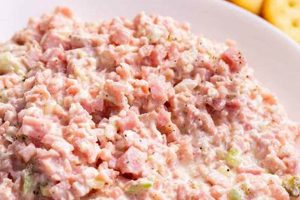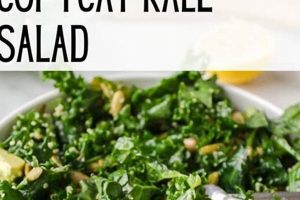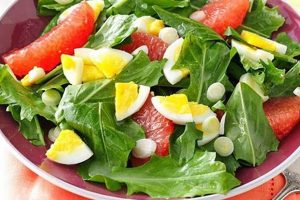Coleslaw, a dish of finely shredded cabbage combined with various dressings, offers a refreshing and versatile culinary experience. Typical preparations involve creamy mayonnaise-based dressings, vinaigrette, or even tangy vinegar-based sauces. Additions such as shredded carrots, onions, and other vegetables enhance flavor and texture, creating diverse variations.
This simple salad provides significant nutritional value, being a rich source of vitamins, minerals, and fiber. Historically, cabbage’s affordability and storability made it a staple ingredient across cultures, leading to a wide array of traditional preparations. Its adaptability allows it to complement various cuisines and occasions, from everyday meals to festive gatherings. Its refreshing qualities make it particularly popular during warmer months.
The following sections explore different approaches to preparing this classic dish, highlighting variations in ingredients, dressings, and regional influences. From classic creamy coleslaw to vibrant Asian-inspired slaws, a range of options are presented to cater to diverse palates and dietary preferences.
Tips for Exceptional Coleslaw
Creating delicious coleslaw involves attention to detail and an understanding of key techniques. The following tips offer guidance for achieving optimal flavor, texture, and presentation.
Tip 1: Cabbage Selection and Preparation: Opt for fresh, firm cabbage heads with crisp leaves. Remove the core and finely shred the cabbage using a sharp knife or mandoline for uniform texture. Soaking the shredded cabbage in ice water for a short period can enhance crispness.
Tip 2: Dressing Considerations: The choice of dressing significantly influences the final flavor profile. Creamy dressings typically utilize mayonnaise as a base, while vinaigrettes offer a lighter, tangier option. Balance sweetness and acidity for a well-rounded taste.
Tip 3: Enhancing Flavor and Texture: Incorporating additional ingredients such as grated carrots, shredded onions, or chopped herbs elevates complexity and visual appeal. Consider adding dried fruits, nuts, or seeds for added texture and nutritional value.
Tip 4: Proper Mixing and Chilling: Combine the shredded cabbage and other ingredients with the dressing gently but thoroughly. Allow the coleslaw to chill in the refrigerator for at least 30 minutes before serving, allowing the flavors to meld and the cabbage to soften slightly.
Tip 5: Avoiding Soggy Coleslaw: Excess moisture can lead to a soggy final product. Ensure vegetables are dry after washing and consider adding the dressing gradually to avoid over-saturation. Salting the shredded cabbage and letting it sit for a while before adding other ingredients can also draw out excess moisture.
Tip 6: Presentation and Serving: Serve coleslaw chilled in an attractive bowl or as a side dish alongside grilled meats, sandwiches, or as part of a buffet. Garnishing with fresh herbs or a sprinkle of paprika enhances visual appeal.
By following these tips, one can consistently achieve a delicious and well-balanced coleslaw. Careful preparation and attention to detail ensure a flavorful and satisfying culinary experience.
These techniques provide a foundation for exploring the various recipes and variations presented in the following sections.
1. Cabbage Variety
Cabbage variety plays a crucial role in determining the final texture and flavor profile of a coleslaw. Different cabbage types offer unique characteristics, influencing the overall culinary experience. Selecting the appropriate variety is essential for achieving the desired outcome.
- Green Cabbage
The most common variety, green cabbage provides a robust, slightly peppery flavor and a crisp texture. Its density holds up well in creamy dressings, making it ideal for classic coleslaw preparations. The outer leaves are typically darker green, while the inner leaves are paler and more tender.
- Red Cabbage
Red cabbage offers a milder, slightly sweeter flavor compared to green cabbage and a vibrant purple hue. Its color adds visual appeal, making it a popular choice for slaws with lighter dressings or those incorporating fruits. The color intensifies with the addition of an acidic element like vinegar.
- Savoy Cabbage
Savoy cabbage features crinkled, textured leaves with a delicate, sweeter flavor than green cabbage. Its tender leaves are best suited for slaws with lighter dressings, where its delicate texture won’t be overwhelmed. It adds a unique visual element.
- Napa Cabbage
Napa cabbage, also known as Chinese cabbage, possesses an oblong shape with elongated, pale green leaves and a mild, slightly sweet flavor. Its tender leaves are often used in Asian-inspired slaws, adding a delicate crunch. It does not hold up as well to heavier dressings.
Understanding the nuances of each cabbage variety allows for informed decisions when creating coleslaw. Consider the desired texture, flavor profile, and dressing type when selecting the most suitable cabbage. The choice will significantly impact the final result, offering a range of possibilities from classic creamy coleslaw to lighter, more nuanced variations.
2. Dressing Choice
Dressing choice profoundly impacts the character of a cabbage salad. The dressing not only provides flavor but also influences texture and overall balance. A well-chosen dressing complements the cabbage and other ingredients, creating a cohesive and satisfying dish. Conversely, an ill-suited dressing can overpower delicate flavors or create an undesirable textural experience. Understanding the interplay between dressing and salad components is crucial for successful recipe development.
Classic creamy coleslaw typically relies on mayonnaise-based dressings. These dressings provide richness and a smooth mouthfeel, clinging well to the shredded cabbage. Variations incorporate buttermilk, sour cream, or yogurt for tang and added complexity. Vinegar, often apple cider or white wine vinegar, provides necessary acidity to balance the richness of the mayonnaise. Sugar or honey adds sweetness, while seasonings like celery seed, mustard, and black pepper contribute depth of flavor. For example, a classic American coleslaw balances the creamy richness of mayonnaise with the tang of vinegar and a touch of sweetness. A lighter, tangier approach might utilize a vinaigrette, emphasizing the freshness of the cabbage and allowing other ingredients to shine. A simple vinaigrette combines oil, vinegar, and seasonings, offering a refreshing counterpoint to the cabbage. Variations incorporate herbs, spices, or citrus zest for added complexity. An Asian-inspired slaw might utilize a sesame-ginger dressing, highlighting umami notes and complementing the addition of ingredients like shredded carrots and chopped peanuts.
Effective dressing selection requires careful consideration of the other salad components. The cabbage variety, additional vegetables, fruits, or nuts, and desired overall flavor profile all influence the ideal dressing choice. A delicate savoy cabbage slaw benefits from a lighter vinaigrette, while a heartier green cabbage slaw can stand up to a richer, creamier dressing. Balancing flavors and textures ensures a harmonious and satisfying culinary experience. Understanding the interplay between dressing and other ingredients allows for informed choices and consistent, delicious results.
3. Added Ingredients
Beyond shredded cabbage, “added ingredients” significantly contribute to the flavor, texture, and nutritional value of coleslaw. These additions transform a simple cabbage salad into a complex and satisfying culinary experience. Strategic incorporation of complementary ingredients elevates the dish, offering a wide range of variations and catering to diverse palates.
- Vegetables
Common vegetable additions include shredded carrots, diced onions, and chopped bell peppers. These contribute not only contrasting textures and colors but also additional vitamins and nutrients. Carrots offer sweetness and a pleasing crunch, while onions provide a pungent bite. Bell peppers introduce a mild sweetness and vibrant color. Other options include shredded jicama, thinly sliced radishes, or chopped celery, each contributing unique flavor and textural nuances.
- Fruits
Incorporating fruits introduces sweetness and acidity, balancing the other flavors in the slaw. Common choices include shredded apples, dried cranberries, or chopped pineapple. Apples provide a tart sweetness and crisp texture, while cranberries offer a chewy texture and tart flavor. Pineapple contributes a tropical sweetness and a juicy texture. Other options include mandarin orange segments, diced pears, or halved grapes, further expanding the flavor and texture possibilities.
- Nuts and Seeds
Nuts and seeds add textural complexity and healthy fats. Toasted sunflower seeds, chopped walnuts, or slivered almonds provide a satisfying crunch and nutty flavor. Pumpkin seeds, sesame seeds, or chopped pecans offer additional options, each contributing a unique flavor profile and nutritional value.
- Herbs and Spices
Fresh herbs like chopped cilantro, parsley, or dill enhance the overall flavor profile, adding brightness and complexity. Dried spices, such as celery seed, caraway seeds, or a pinch of cayenne pepper, contribute depth and warmth. The choice of herbs and spices should complement the other ingredients and the chosen dressing.
The careful selection and combination of added ingredients elevates coleslaw from a simple side dish to a complex and flavorful salad. By understanding the interplay of flavors, textures, and colors, one can create a wide variety of coleslaw variations, each offering a unique culinary experience. The possibilities are vast, allowing for customization and adaptation to individual preferences and dietary needs.
4. Preparation Technique
Preparation technique significantly influences the final quality and enjoyment of coleslaw. Proper techniques ensure optimal texture, prevent sogginess, and maximize flavor development. From initial cabbage selection and handling to final dressing incorporation, each step contributes to the overall success of the dish. Understanding these techniques allows for consistent creation of delicious and appealing coleslaw.
- Cabbage Selection and Handling
Choosing a fresh, firm cabbage head is paramount. Avoid cabbages with wilted or bruised leaves. Proper storage, in a cool, dry place, maintains freshness. Prior to shredding, remove the core and any damaged outer leaves. Rinsing the cabbage thoroughly and drying it completely prevents excess moisture, which can lead to a watery final product.
- Shredding Technique
Uniform shredding ensures even coating with dressing and consistent texture. A sharp knife or mandoline produces finely shredded cabbage, ideal for coleslaw. Coarsely chopped cabbage may result in uneven dressing distribution and a less appealing texture. Consistent size promotes even flavor absorption and a pleasant mouthfeel.
- Dressing Incorporation and Timing
Adding the dressing just before serving prevents the cabbage from becoming soggy. Thorough but gentle mixing ensures even distribution of the dressing, coating each strand of cabbage. For optimal flavor development, allowing the coleslaw to chill in the refrigerator for at least 30 minutes after dressing allows the flavors to meld. However, extended chilling can also lead to sogginess, so timing is crucial.
- Moisture Control
Excess moisture is a common challenge in coleslaw preparation. Salting the shredded cabbage and allowing it to sit before adding other ingredients draws out excess water, preventing a watery final product. This step is particularly important when using dressings with a higher liquid content. Thoroughly drying the cabbage after rinsing also contributes to moisture control. Using thicker dressings or adding them gradually helps prevent over-saturation.
These fundamental preparation techniques are essential for creating successful coleslaw. Attention to detail in each step, from cabbage selection to dressing incorporation, ensures optimal texture, flavor, and overall enjoyment. Mastery of these techniques provides a solid foundation for exploring diverse coleslaw variations and consistently achieving delicious results.
5. Flavor Balance
Flavor balance is paramount in achieving a successful cabbage salad. A harmonious blend of contrasting yet complementary tastes elevates this simple dish, transforming it into a complex and satisfying culinary experience. A well-balanced slaw engages the palate with a dynamic interplay of flavors, avoiding monotony and ensuring enjoyment. Understanding the key components of flavor balance allows for informed recipe development and consistent results.
- Acidity
Acidity, often provided by vinegar or citrus juice, provides a necessary counterpoint to richness and sweetness. It brightens the flavors, preventing the slaw from becoming cloying. The level of acidity should be carefully calibrated to complement the other ingredients. For instance, a creamy slaw benefits from a more pronounced acidity to cut through the richness of the mayonnaise, while a lighter vinaigrette-based slaw might require a gentler touch. Common acidic ingredients include apple cider vinegar, white wine vinegar, lemon juice, and lime juice.
- Sweetness
Sweetness balances acidity and adds depth of flavor. Sugar, honey, or the natural sweetness of fruits like shredded apples or dried cranberries contribute to the overall flavor profile. The level of sweetness should complement the other ingredients and the chosen dressing. A creamy slaw might benefit from a touch of sweetness to balance the tang of the vinegar, while a slaw featuring tart fruits might require less added sugar. The sweetness level should never overpower the other flavors but rather enhance the overall balance.
- Saltiness
Salt enhances the other flavors in the slaw and is essential for a well-rounded taste. Salt not only seasons the dish but also draws out moisture from the cabbage, preventing a watery final product. The amount of salt should be carefully considered, avoiding over-salting, which can mask the other flavors. Sea salt or kosher salt are preferred for their clean flavor and consistent texture.
- Umami
Umami, often described as a savory, meaty flavor, adds depth and complexity. Ingredients like fish sauce, soy sauce, or grated Parmesan cheese contribute umami notes. While not always a prominent flavor in coleslaw, a touch of umami can significantly enhance the overall taste profile, particularly in Asian-inspired slaws or those featuring richer dressings. Careful consideration should be given to the intensity of the umami ingredient to ensure it complements the other flavors without overpowering them.
Careful consideration of these elements ensures a well-balanced and flavorful cabbage salad. The interplay of acidity, sweetness, saltiness, and umami creates a dynamic and enjoyable culinary experience. A harmonious balance of these elements prevents any single flavor from dominating, allowing the nuances of each ingredient to shine through. Mastery of flavor balance transforms a simple coleslaw into a sophisticated and satisfying dish.
Frequently Asked Questions
This section addresses common inquiries regarding cabbage salad preparation, offering practical solutions and clarifying potential misconceptions. Understanding these aspects contributes to successful outcomes and enhances the overall culinary experience.
Question 1: How can sogginess in coleslaw be prevented?
Sogginess results from excess moisture. Salting shredded cabbage and allowing it to rest before combining with other ingredients draws out excess water. Thorough drying after rinsing also helps. Adding dressing just before serving further mitigates this issue. Gradually incorporating the dressing allows for better moisture control.
Question 2: What are suitable cabbage alternatives for coleslaw?
While cabbage provides the traditional base, alternatives offer variations in flavor and texture. Finely shredded Brussels sprouts offer a slightly more assertive, peppery taste. Broccoli slaw provides a milder flavor and more substantial texture. Shredded kohlrabi offers a subtly sweet and crisp alternative.
Question 3: How can the shelf life of coleslaw be extended?
Storing coleslaw in an airtight container in the refrigerator helps maintain its quality. Optimal storage temperature ranges from 35-40F (2-4C). Properly stored coleslaw typically remains fresh for 3-5 days, though its quality may gradually decline. Keeping the dressing separate until just before serving further extends shelf life.
Question 4: What are effective methods for enhancing flavor complexity?
Layering flavors through various techniques adds depth and complexity. Incorporating toasted nuts or seeds provides a contrasting texture and nutty notes. Adding dried fruits introduces sweetness and chewiness. Fresh herbs contribute brightness and aromatic complexity. Spices such as celery seed or caraway seed offer distinctive flavor profiles.
Question 5: How can coleslaw be adapted for different dietary needs?
Adapting recipes caters to various dietary restrictions. Substituting vegan mayonnaise creates a plant-based version. Using alternative sweeteners like maple syrup or agave nectar accommodates specific dietary preferences. Focusing on whole-food ingredients and minimizing processed elements aligns with clean-eating principles. Ensuring all added ingredients align with specific dietary restrictions is crucial.
Question 6: What are common mistakes to avoid in coleslaw preparation?
Overdressing leads to a soggy, less appealing slaw. Incorporating the dressing gradually prevents this issue. Using dull knives results in unevenly shredded cabbage, affecting both texture and aesthetic appeal. Neglecting to properly dry the cabbage after rinsing contributes to excess moisture. Ignoring proper storage practices compromises freshness and flavor.
Addressing these common inquiries provides a foundation for successful coleslaw preparation. Attention to detail and an understanding of these key aspects ensure consistently delicious and satisfying results.
This concludes the frequently asked questions section. The next section will offer a collection of diverse recipes, allowing for practical application of the principles discussed and exploration of various flavor profiles and ingredient combinations.
Recipes for Cabbage Salad
Exploration of cabbage salad recipes reveals a versatile dish adaptable to diverse culinary preferences. Careful selection of cabbage variety, dressing, and added ingredients allows for a wide range of flavor profiles and textures. Proper preparation techniques, including shredding, moisture control, and dressing incorporation, are crucial for achieving optimal results. A well-balanced flavor profile, encompassing acidity, sweetness, saltiness, and umami, elevates cabbage salad from a simple side dish to a complex and satisfying culinary experience. Addressing common preparation challenges, such as preventing sogginess, and understanding ingredient substitutions further enhances culinary expertise.
Cabbage salad’s adaptability and nutritional value position it as a valuable component of a balanced diet. Continued exploration of flavor combinations and regional variations promises further culinary discoveries. This foundational knowledge empowers culinary enthusiasts to create innovative and delicious cabbage salad variations, enriching culinary experiences.






